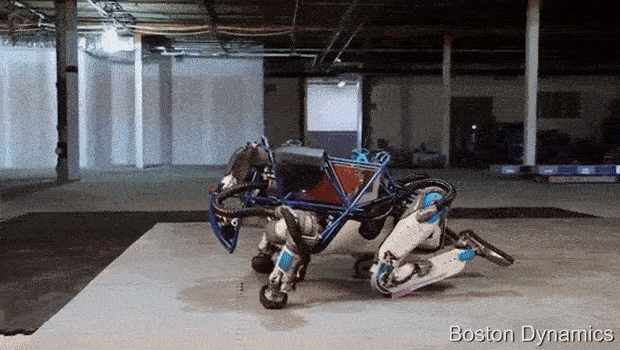Boston Dynamics has just posted an incredible video showcasing a massively upgraded version of the ATLAS robot that they initially developed for the DARPA Robotics Challenge. While BD calls this the “next generation” of ATLAS, it looks like such an enormous technological leap forward that it’s more like a completely different species.
“A new version of Atlas, designed to operate outdoors and inside buildings. It is electrically powered and hydraulically actuated. It uses sensors in its body and legs to balance and LIDAR and stereo sensors in its head to avoid obstacles, assess the terrain and help with navigation. This version of Atlas is about 5’ 9” tall (about a head shorter than the DRC Atlas) and weighs 180 lbs.”

A few quick notes:
- At 5’9” (1.75 m) and 180 lbs (82 kg), the new ATLAS is much shorter and lighter than the previous model, which was 6’2” (1.9 m) and 345 lbs (156 kg). See family photo above for comparison.
- It looks like BD decided that electric motors aren’t yet up to the task of getting a 180-pound robot to walk around, so they stuck with the more complicated (and generally messier) hydraulic system. Other legged robots do this too, and it seems like a reasonable compromise between the quiet efficiency of electricity and the power of hydraulics.
- That dynamic balancing reminds us a lot of the early BigDog videos, but it’s crazy to see it running in a biped like this, because of the speed at which the limbs have to move while still supporting the upper body.
- We’re not exactly sure how much autonomy it’s got going at this point. While walking outdoors, the LIDAR appears not to be spinning much of the time, which means someone is likely driving the robot. Some of the box lifting looks to be autonomous, but we’re definitely looking for some background on what’s going on behind the scenes when the robot is stacking boxes on those shelves.
- It can fall over, and not only not die, but get up again by itself. There were a few layers of mats underneath the robot, and one video doesn’t reveal a whole lot about its overall robustness, but this is miles better than any other humanoid robot short of CHIMP (if you want to call CHIMP a humanoid).
We’ve pinged Boston Dynamics to see if we can get any more details, and if we do, you’ll see them here first. UPDATE 2/24/16:We spoke with Boston Dynamics founder Marc Raibert, who gave us more details on how his team built the new ATLAS.
[ Boston Dynamics ]
Evan Ackerman is a senior editor at IEEE Spectrum. Since 2007, he has written over 6,000 articles on robotics and technology. He has a degree in Martian geology and is excellent at playing bagpipes.
Erico Guizzo is the Director of Digital Innovation at IEEE Spectrum, and cofounder of the IEEE Robots Guide, an award-winning interactive site about robotics. He oversees the operation, integration, and new feature development for all digital properties and platforms, including the Spectrum website, newsletters, CMS, editorial workflow systems, and analytics and AI tools. An IEEE Member, he is an electrical engineer by training and has a master’s degree in science writing from MIT.



